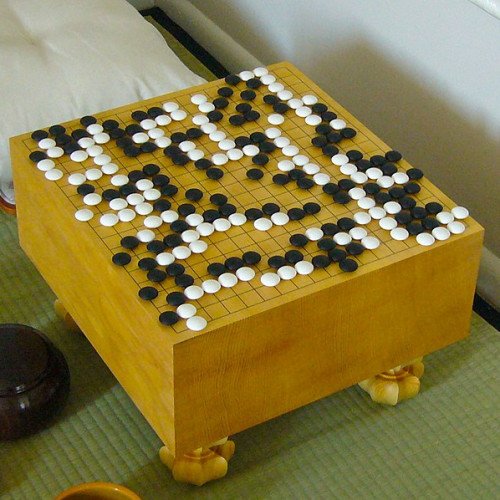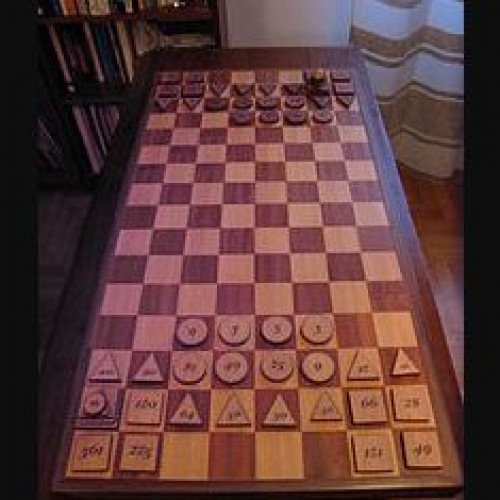GO VS RITHMOMACHY

GO
Go is an abstract strategy board game for two players in which the aim is to surround more territory than the opponent. The game was invented in China more than 2,500 years ago and is believed to be the oldest board game continuously played to the present day. A 2016 survey by the International Go Federation's 75 member nations found that there are over 46 million people worldwide who know how to play Go and over 20 million current players, the majority of whom live in East Asia. The playing pieces are called stones. One player uses the white stones and the other, black. The players take turns placing the stones on the vacant intersections (points) of a board. Once placed on the board, stones may not be moved, but stones are removed from the board if the stone (or group of stones) is surrounded by opposing stones on all orthogonally-adjacent points, in which case the stone is captured. The game proceeds until neither player wishes to make another move. When a game concludes, the winner is determined by counting each player's surrounded territory along with captured stones and komi (points added to the score of the player with the white stones as compensation for playing second). Games may also be terminated by resignation. The standard Go board has a 19×19 grid of lines, containing 361 points. Beginners often play on smaller 9×9 and 13×13 boards, and archaeological evidence shows that the game was played in earlier centuries on a board with a 17×17 grid. However, boards with a 19×19 grid had become standard by the time the game reached Korea in the 5th century CE and Japan in the 7th century CE. Go was considered one of the four essential arts of the cultured aristocratic Chinese scholars in antiquity. The earliest written reference to the game is generally recognized as the historical annal Zuo Zhuan (c. 4th century BCE). Despite its relatively simple rules, Go is extremely complex. Compared to chess, Go has both a larger board with more scope for play and longer games and, on average, many more alternatives to consider per move. The number of legal board positions in Go has been calculated to be approximately 2.1 × 10170, which is vastly greater than the number of atoms in the known, observable universe, estimated to be about 1 × 1080.
Statistics for this Xoptio

RITHMOMACHY
Rithmomachy (or Rithmomachia, also Arithmomachia, Rythmomachy, Rhythmomachy, or several other variants; sometimes known as The Philosophers' Game) is a highly complex, early European mathematical board game. The earliest known description of it dates from the eleventh century. A literal translation of the name is "The Battle of the Numbers". The game is much like chess, except most methods of capture depend on the numbers inscribed on each piece. It has been argued that between the twelfth and sixteenth centuries, "rithmomachia served as a practical exemplar for teaching the contemplative values of Boethian mathematical philosophy, which emphasized the natural harmony and perfection of number and proportion. The game, Moyer argues, was used both as a mnemonic drill for the study of Boethian number theory and, more importantly, as a vehicle for moral education, by reminding players of the mathematical harmony of creation." Very little, if anything, is known about the origin of the game. Medieval writers attributed it to Pythagoras, but no trace of it has been discovered in Greek literature, and the earliest mention of it is from the time of Hermannus Contractus (1013–1054). The name, which appears in a variety of forms, points to a Greek origin, the more so because Greek was little known at the time when the game first appeared in literature. Based upon the Greek theory of numbers, and having a Greek name, it is still speculated by some that the game originated in Greek civilization, perhaps in the later schools of Byzantium or Alexandria. The first written evidence of Rithmomachia dates to around 1030, when a monk named Asilo created a game that illustrated the number theory of Boëthius' De institutione arithmetica, for the students of monastery schools. The rules of the game were improved shortly thereafter by another monk, Hermannus Contractus from Reichenau, and in the school of Liège. In the following centuries, Rithmomachia spread quickly through schools and monasteries in the southern parts of Germany and France. It was used mainly as a teaching aid, but gradually intellectuals started to play it for pleasure. In the 13th century Rithmomachia came to England, where famous mathematician Thomas Bradwardine wrote a text about it. Even Roger Bacon recommended Rithmomachia to his students, while Sir Thomas More let the inhabitants of the fictitious Utopia play it for recreation. The game was well enough known as to justify printed treatises in Latin, French, Italian, and German, in the sixteenth century, and to have public advertisements of the sale of the board and pieces under the shadow of the old Sorbonne.